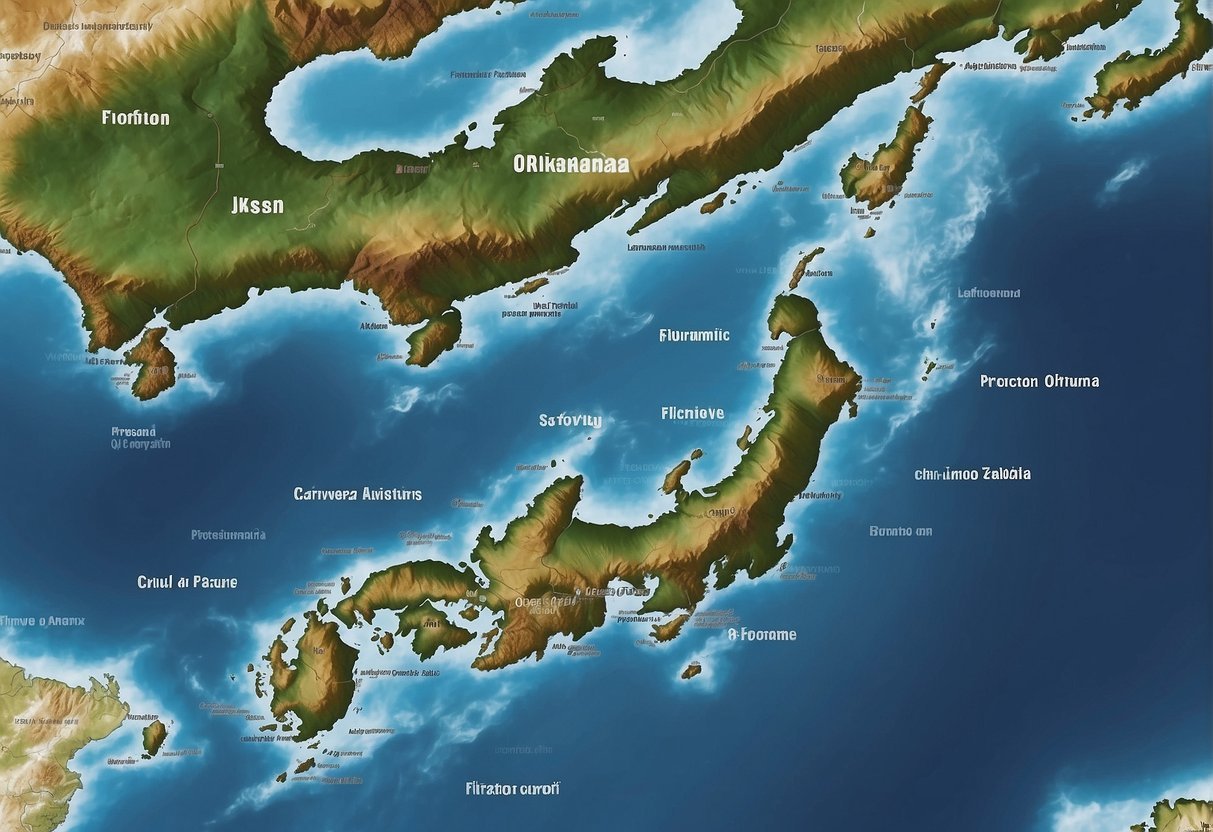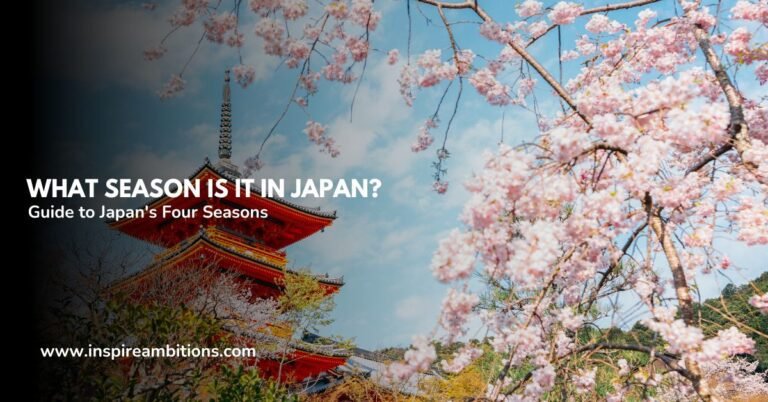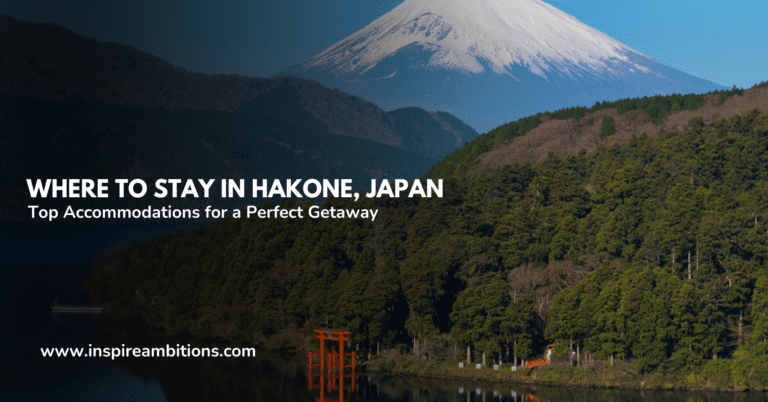Map of Japan and Okinawa – A Comprehensive Guide for Travelers
Navigating the archipelago of Japan requires an up-to-date map that routes you through its rich landscape and cultural landmarks. When you explore a map of Japan, you’ll find it’s not just about locating a city or a prefecture; it’s a gateway to understanding this island nation’s geography and regional differences.
Japan’s intricate web of islands includes the well-known island chain of Okinawa, situated to the southwest and distinct from the main islands, offering a unique blend of cultural and historical flavours.
Okinawa proves fascinating on a map, revealing its position as a strategic and beautiful part of Japan. If you’re looking at an Okinawa map, each point tells a story of sandy beaches, traditional Ryukyu Kingdom castles, and remnants of World War II.
It’s not only about the aesthetic appeal of turquoise waters but also about the practical uses of these maps for tourists and history enthusiasts alike.
Remember, while maps guide you to your next destination, they can also serve as historical documents and cultural capsules.
Whether you’re tracing the paths of ancient samurais, seeking the serenity of Okinawa’s beaches, or planning an efficient business trip, a comprehensive map is your must-have companion for making the most of Japan’s diverse offerings.
Geografía y clima

Exploring Japan and Okinawa’s intricate geography and diverse climate gives insight into these regions’ unique environmental characteristics.
Okinawa Prefecture Overview
Okinawa Prefecture is located in the southernmost part of Japan, consisting of numerous islands that form part of the Ryukyu Islands. The Okinawa region is well-known for its tropical climate, coral reefs, and abundant marine life. Naha, the capital, is the political and economic hub of Okinawa Prefecture.
Main Islands and Archipelagoes
Japan consists of a series of islands along the Pacific coast of East Asia. The main islands are Hokkaido, Honshu, Kyushu, and Shikoku. Okinawa is part of the Ryukyu Islands archipelago, located approximately 380 miles southwest of Kyushu. These islands, including the Yaeyama Islands group, are often celebrated for their rich cultural history and biodiversity.
Climate Characteristics
Japan and Okinawa enjoy varying climatic zones due to their extensive north-to-south range. Most of Japan experiences four distinct seasons, while Okinawa has a humid subtropical climate characterized by mild winters and long, muggy summers.
Proximity to the Pacific Ocean significantly influences weather patterns, with typhoons being a notable feature of the environment in Okinawa.
Historical and Cultural Context
In this section, we explore the rich historical and cultural tapestry of Okinawa within the map of Japan. You’ll unearth the island’s past significance, understand the profound Ryukyuan cultural heritage, and discover how contemporary culture and arts continue to shape Okinawa today.
Significado historico
Okinawa, the southernmost prefecture of Japan, has a unique historical background that sets it apart from the rest of the country. Its strategic location led to World War II, which played a pivotal role in shaping the island’s destiny. After a devastating battle, Okinawa came under American administration before reverting to Japanese governance in 1972. A significant artefact, a hand-drawn map of Okinawa, offers a glimpse into the island’s 19th-century landscape.
Ryukyuan Cultural Heritage
El Ryukyuan Culture is a cornerstone of Okinawa’s identity. Shuri Castle, once the royal seat of the Ryukyu Kingdom, exemplifies the region’s architectural ingenuity and historical importance. Despite suffering damage, the castle symbolizes the island’s heritage.
Okinawa’s traditional karate has evolved over centuries, deeply ingrained in the local culture. The language reflects its diverse influences, where Okinawan dialects exhibit a melodic difference from mainland Japanese.
Contemporary Culture and Arts
Today’s Okinawan culture is a vibrant blend of traditional and modern elements. festivales like the Eisa Dance Festival connect the community through rhythmic drumming and lively performances. At the same time, local cuisine like Goya Champuru gives you a taste of the island’s unique flavours.
Craftsmanship also thrives, with Okinawan pottery and textiles sought after for their quality and aesthetic. Moreover, the arts in Okinawa range from contemporary music that resonates with the Okinawan heartstrings to visual arts that depict the island’s natural beauty and complex history.
Political and Economic Landscape
Japan’s political and economic landscape is a complex tapestry, particularly in Okinawa Prefecture, which has a distinct identity from the mainland. Here, you’ll explore the administrative divisions that shape governance, the economy with its unique challenges and opportunities, and the nuanced military relationships that impact the region.
Administrative Divisions
El Land of the Rising Sun is divided into prefectures, with Okinawa being the southernmost. Okinawa Prefecture consists of dozens of islands, the largest of which is Okinawa Island, where the prefectural capital, Naha, is located.
Despite comprising only around 0.6% of Japan’s land area, Okinawa’s administrative divisions have significant autonomy compared to other prefectures.
Economía e Industria
Okinawa’s economy is distinct, with a lesser focus on manufacturing and a greater reliance on servicios y turismo. Unfortunately, the prefecture has lower average income levels compared to mainland Japan.
- Agriculture plays a role in the cultivation of sugarcane and tropical fruits.
- Population density is high in urban areas, intensifying the demand for jobs and services.
Due to the American occupation post-World War II, military bases have a complex influence on the local economy.
Military Presence and Relations
Okinawa hosts many U.S. military bases, covering around 18% of Okinawa Island’s land area. These bases are a point of political tension but also provide employment and stimulate the local economy.
- Military Bases: Controversial yet economically impactful.
- American Occupation: Led to a lasting military presence.
- Okinawan Relations: Residents have mixed feelings, balancing economic benefits with a desire for autonomy.
Understanding Okinawa’s political and economic landscape requires acknowledging its complex history’s unique challenges, opportunities, and continuing developments.
Tourism and Attractions
Japan brims with extraordinary sites, and Okinawa is a jewel in its crown, offering natural wonders, rich history, and exciting recreational activities. Here’s what you can look forward to when you visit.
Natural Wonders and Parks
Okinawa is a paradise of belleza natural. At the heart of it, Cape Manza boasts stunning views of dramatic cliffs against the backdrop of the East China Sea. The Miyako Islands are a spectacle for sore eyes and are home to some of Japan’s best beaches.
Visitando Kumejima offers serene beaches and underwater adventures amidst vibrant coral reefs. Okinawa Churaumi Aquarium, a highlight in Motobu, displays a fascinating variety of marine life, providing insights into the mysterious underwater world.
- Cape Manza: Renowned for its extraordinary cliff views.
- Miyako Islands: Brilliant for beaches and sun-soaked relaxation.
- Okinawa Churaumi Aquarium: Features a vast array of marine species.
Historical Sites and Monuments
Okinawa’s history is both distinguished and deeply felt. The islands’ historical narrative unfolds at landmarks like the Shuri Castle, symbolizing the Ryukyu Kingdom’s legacy.
Additionally, festivals like the Shuri Castle Festival celebrate this rich heritage annually. In Itoman, war memorials poignantly recount the past, providing a space for reflection and remembrance.
- Shuri Castle: A glimpse into the royal courts of Ryukyu kings.
- Shuri Castle Festival: A vibrant celebration rooted in Okinawan history.
Actividades recreativas
For the thrill-seekers and explorers, Okinawa is a dream. The island chain offers unparalleled opportunities for diving, particularly in areas like Ishigaki y el Remote Islands, where divers can plunge into a world of exquisite corals and marine wildlife.
Back on land, Kunigami District captures the hearts of nature lovers with its pristine forests. Further down in Onna, resorts cater to those seeking a blend of luxury and outdoor enjoyment.
- Diving in Ishigaki: Discover a mesmerizing underwater landscape.
- Kunigami District: Perfect for trail enthusiasts and nature lovers.
By visiting Okinawa, you’ll create unforgettable memories as you explore its stunning parks, dive into history, and engage in exhilarating activities.






